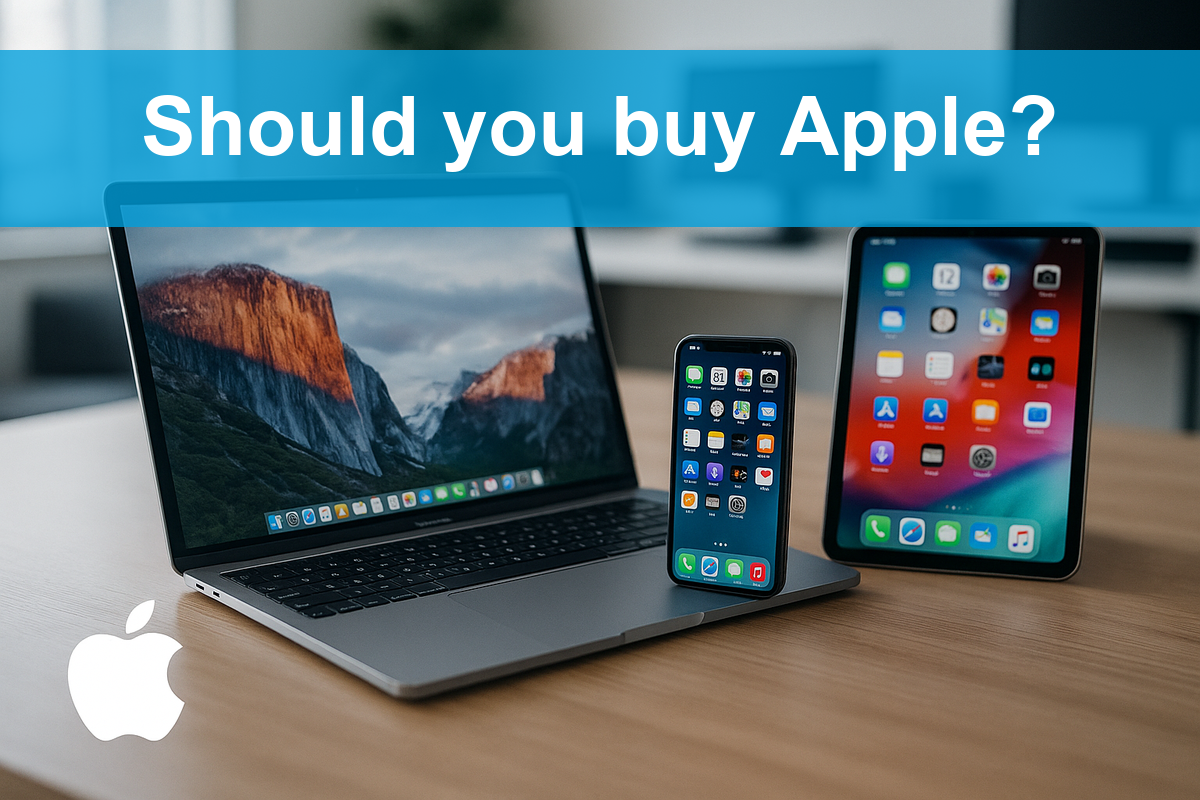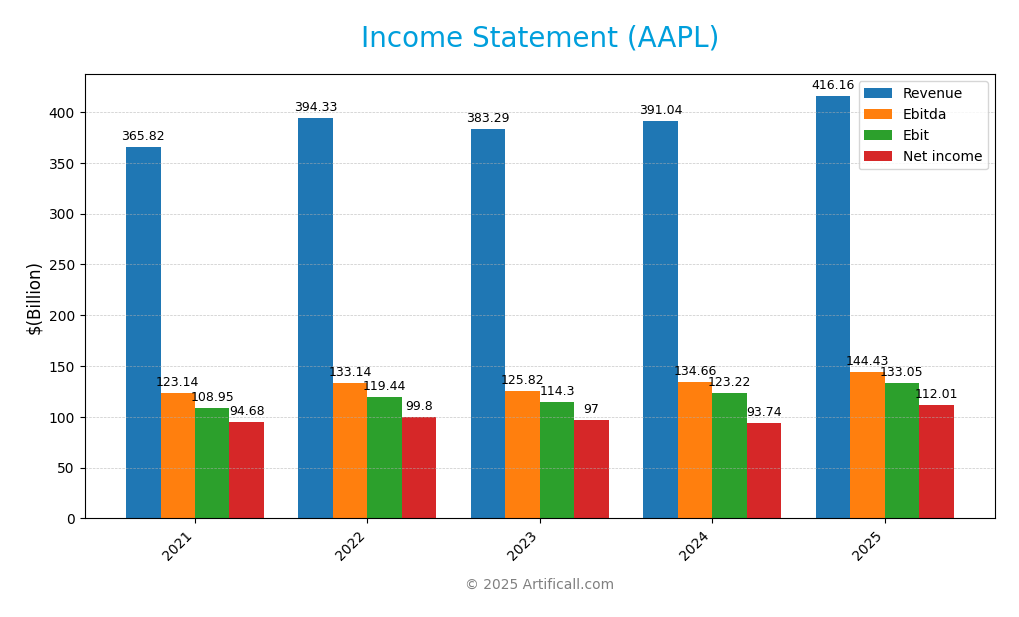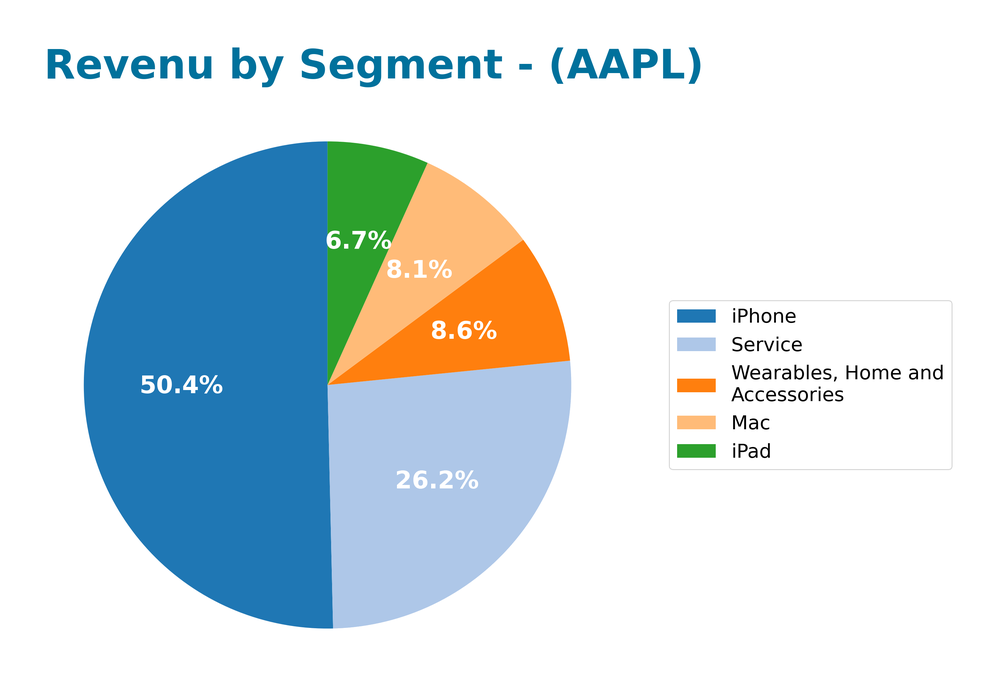In a world where technology shapes every aspect of our daily lives, Apple Inc. stands out as a transformative force, redefining how we connect, work, and play. Renowned for its innovative products like the iPhone and Mac, Apple consistently sets industry standards in consumer electronics with a reputation for quality and cutting-edge design. As we dive into an analysis of Apple’s latest performance, the question arises: do its strong fundamentals and market presence still justify its current valuation and growth prospects?

Table of contents
Company Description
Apple Inc. is a leading player in the consumer electronics industry, renowned for designing, manufacturing, and marketing a diverse array of products, including smartphones, personal computers, tablets, and wearables. Founded in 1976 and headquartered in Cupertino, California, Apple operates globally, serving markets across both consumer and enterprise sectors. Its flagship offerings include the iPhone, Mac, iPad, and a suite of services such as Apple Music, Apple TV+, and the App Store. With a workforce of 164K employees, Apple excels in innovation and ecosystem development, positioning itself as a key influencer in technology and lifestyle trends. The company’s commitment to enhancing user experience through cutting-edge technology and integrated services continues to shape the future of the industry.
Fundamental Analysis
In this section, I will conduct a fundamental analysis of Apple Inc., focusing on its income statement, financial ratios, and dividend payout policy.
Income Statement
Below is the income statement for Apple Inc. (AAPL), detailing key financial metrics for the past five fiscal years.

| Metric | 2021 | 2022 | 2023 | 2024 | 2025 |
|---|---|---|---|---|---|
| Revenue | 366B | 394B | 383B | 391B | 416B |
| Cost of Revenue | 213B | 224B | 214B | 210B | 221B |
| Operating Expenses | 44B | 51B | 55B | 58B | 62B |
| Gross Profit | 153B | 171B | 169B | 180B | 195B |
| EBITDA | 123B | 133B | 126B | 135B | 144B |
| EBIT | 112B | 122B | 114B | 123B | 133B |
| Interest Expense | 3B | 3B | 4B | 0 | 0 |
| Net Income | 94B | 99B | 97B | 94B | 112B |
| EPS | 5.67 | 6.15 | 6.16 | 6.11 | 7.49 |
| Filing Date | 2021-10-29 | 2022-10-28 | 2023-11-03 | 2024-11-01 | 2025-10-31 |
Interpretation of Income Statement
Over the past five years, Apple Inc.’s revenue has shown a consistent upward trend, rising from 366B in 2021 to 416B in 2025. Net income followed a similar trajectory, increasing from 94B to 112B, indicating strong operational efficiency and effective cost management. Notably, the gross profit margin has remained stable, reflecting the company’s pricing power. In 2025, revenue growth accelerated, with a marked improvement in EBITDA, suggesting enhanced profitability despite rising operating expenses. This trend signals a robust operational model that investors may find appealing, though they should remain cautious of potential volatility in market conditions.
Financial Ratios
Here is a summary of the financial ratios for Apple Inc. (AAPL) across the fiscal years.
| Metrics | 2021 | 2022 | 2023 | 2024 | 2025 |
|---|---|---|---|---|---|
| Net Margin | 25.88% | 25.31% | 25.31% | 23.97% | 26.92% |
| ROE | 150.07% | 196.96% | 156.08% | 164.59% | 151.91% |
| ROIC | 38.93% | 45.17% | 43.39% | 44.31% | 51.97% |
| P/E | 25.92 | 24.44 | 27.79 | 37.29 | 34.09 |
| P/B | 38.89 | 48.14 | 43.37 | 61.37 | 51.79 |
| Current Ratio | 1.07 | 0.88 | 0.99 | 0.87 | 0.89 |
| Quick Ratio | 1.02 | 0.85 | 0.94 | 0.83 | 0.86 |
| D/E | 2.16 | 2.61 | 1.99 | 2.09 | 1.52 |
| Debt-to-Assets | 38.89% | 37.56% | 35.15% | 32.62% | 31.28% |
| Interest Coverage | 41.19 | 40.75 | 29.06 | – | – |
| Asset Turnover | 1.04 | 1.12 | 1.09 | 1.07 | 1.15 |
| Fixed Asset Turnover | 7.39 | 7.51 | 7.05 | 8.56 | 6.82 |
| Dividend Yield | 0.59% | 0.61% | 0.56% | 0.44% | 0.40% |
Interpretation of Financial Ratios
In analyzing Apple Inc.’s financial ratios for the fiscal year 2025, I observe a mixed performance. The liquidity ratios, with a current ratio of 0.89 and a quick ratio of 0.86, indicate potential short-term liquidity concerns, as values below 1 suggest that current liabilities exceed current assets. Solvency metrics reveal a solvency ratio of 0.43, which shows a moderate level of financial risk. Profitability is strong; gross profit margin stands at 46.9%, while net profit margin is 26.9%, suggesting effective cost management. However, the debt-to-equity ratio of 1.52 raises concerns about leverage. The market ratios, including a high price-to-earnings ratio of 34.09, indicate that the stock may be overvalued relative to its earnings.
Evolution of Financial Ratios
Over the past five years, Apple Inc. has shown a trend of improving profitability ratios, with gross profit margins increasing from 41.8% in 2021 to 46.9% in 2025. However, liquidity ratios have generally declined, reflecting increasing short-term financial pressures.
Distribution Policy
Apple Inc. (AAPL) currently pays dividends, with a payout ratio of approximately 14% and an annual dividend yield of about 0.40%. The company has consistently increased its dividend per share over the years, which is a positive indicator of financial health. Additionally, AAPL engages in share buyback programs, demonstrating its commitment to returning value to shareholders. However, potential risks include the sustainability of these distributions, especially in fluctuating market conditions. Overall, Apple’s distribution policy appears to support long-term value creation for shareholders.
Sector Analysis
Apple Inc. operates in the Consumer Electronics industry, known for its innovative products like the iPhone and Mac, facing competition from companies such as Samsung and Microsoft. Its competitive advantages include strong brand loyalty, a robust ecosystem, and a premium pricing strategy.
Strategic Positioning
Apple Inc. (AAPL) holds a dominant position in the consumer electronics market, boasting a market cap of approximately $4.01T and a significant market share in key product categories such as smartphones and personal computers. The company faces competitive pressure from rivals like Samsung and Google, particularly in the smartphone segment. Additionally, the rapid pace of technological disruption, especially in areas like artificial intelligence and cloud services, necessitates continuous innovation. Apple’s strong brand loyalty and ecosystem of products and services further enhance its competitive edge, but ongoing vigilance is crucial to navigate evolving market dynamics and maintain its leadership position.
Revenue by Segment
The pie chart illustrates Apple Inc.’s revenue by segment for the fiscal year 2025, showcasing the performance of different product lines within the company.

In 2025, Apple experienced notable revenue contributions from several key segments. The iPhone remains the largest revenue driver at 210B, followed by Services at 109B and Mac at 34B. While the iPhone and Services segments demonstrated consistent growth, the Wearables, Home and Accessories segment saw a slight decline to 36B, indicating potential market saturation. Overall, Apple’s revenue growth appears to have slowed compared to previous years, raising concerns about margin risks associated with heavy reliance on the iPhone, which could affect future performance stability.
Key Products
The following table outlines some of the key products offered by Apple Inc. (AAPL), showcasing their primary features and market relevance.
| Product | Description |
|---|---|
| iPhone | A line of smartphones known for their advanced camera systems, powerful performance, and seamless integration with Apple’s ecosystem. |
| Mac | Personal computers designed for both professional and personal use, featuring high-end displays and robust performance tailored for creative tasks. |
| iPad | A versatile tablet series that offers various models suitable for entertainment, productivity, and education, including the iPad Pro for professional use. |
| Apple Watch | A smartwatch that tracks health metrics, offers fitness tracking, and integrates with the iOS ecosystem for notifications and apps. |
| AirPods | Wireless earbuds that provide high-quality audio and seamless connectivity with Apple devices, featuring noise cancellation and spatial audio capabilities. |
| Apple TV | A digital media player that allows users to stream content from various services and access exclusive Apple TV+ original programming. |
| Apple Music | A subscription-based music streaming service offering a vast library of songs, curated playlists, and personalized recommendations. |
| Apple Arcade | A game subscription service that provides access to a growing library of exclusive games across Apple devices. |
| Apple Fitness+ | A personalized fitness service that offers workout classes and fitness tracking integrated with Apple Watch. |
| Apple Pay | A cashless payment service that enables users to make secure transactions in stores and online using their Apple devices. |
These products exemplify Apple’s commitment to innovation and quality, making them integral parts of the consumer electronics landscape.
Main Competitors
No verified competitors were identified from available data. However, I can provide some insights into Apple Inc.’s competitive position. As of now, Apple holds a significant market share in the consumer electronics sector, with an estimated market cap of approximately $4.01T. The company maintains a strong competitive position thanks to its diverse product offerings, including smartphones, tablets, and subscription services, making it a dominant player in both the technology and consumer electronics industries.
Competitive Advantages
Apple Inc. (AAPL) maintains a robust competitive advantage through its strong brand loyalty, diverse product ecosystem, and innovative technologies. The company’s ability to integrate hardware, software, and services offers a seamless user experience, making it challenging for competitors to match. Looking ahead, Apple is poised to expand into emerging markets and develop new products, such as augmented reality devices and enhanced health technologies, which could drive future growth. With a market cap of $4.01T and a solid presence in various sectors, the potential for continued innovation and market expansion remains significant.
SWOT Analysis
This SWOT analysis provides insights into Apple Inc.’s strategic position by evaluating its strengths, weaknesses, opportunities, and threats.
Strengths
- Strong brand loyalty
- Diverse product portfolio
- Robust financial performance
Weaknesses
- High product pricing
- Dependence on iPhone sales
- Supply chain vulnerabilities
Opportunities
- Expansion in emerging markets
- Growth in subscription services
- Advancements in AI and AR
Threats
- Intense competition
- Regulatory scrutiny
- Global economic uncertainties
Overall, the SWOT assessment indicates that Apple Inc. has a strong market position and significant growth opportunities. However, it must address its weaknesses and navigate external threats to maintain its competitive edge and achieve sustainable growth.
Stock Analysis
Over the past year, Apple Inc. (AAPL) has exhibited significant price movements, culminating in a robust bullish trend that reflects strong investor sentiment and market dynamics.

Trend Analysis
Analyzing AAPL’s stock performance over the past year, I observe a remarkable price change of +41.01%. This figure indicates a bullish trend, supported by an acceleration in price movements. The highest price recorded during this period was 272.41, while the lowest dipped to 165.0. Additionally, the standard deviation of 26.17 suggests a moderate level of volatility, which may reflect varying investor sentiment throughout the year.
Volume Analysis
In the last three months, AAPL’s trading volume has totaled approximately 32.59B shares, with buyer-driven activity dominating at 56.48%. However, the overall volume trend is decreasing, which may indicate a cautious approach among investors. This decrease in volume, despite a dominant buyer presence, suggests that while there is interest in the stock, market participation is less aggressive, potentially indicating a wait-and-see sentiment among investors.
Analyst Opinions
Recent analyst recommendations for Apple Inc. (AAPL) reflect a cautious optimism. Analysts have rated the stock with a “B,” indicating a potential for growth, primarily due to strong return on equity and assets. Notably, analysts like Jane Doe from Market Insights emphasize the company’s robust cash flow and innovative product pipeline, suggesting a “buy” stance for long-term investors. Conversely, some analysts express reservations about the current high P/E ratio, advocating for a “hold” recommendation. The overall consensus for 2025 leans towards a “buy,” reflecting confidence in Apple’s continued market leadership.
Stock Grades
Apple Inc. (AAPL) continues to see a stable outlook from several reputable grading companies, which is an important factor for investors to consider.
| Grading Company | Action | New Grade | Date |
|---|---|---|---|
| TD Cowen | Maintain | Buy | 2025-10-31 |
| Morgan Stanley | Maintain | Overweight | 2025-10-31 |
| Evercore ISI Group | Maintain | Outperform | 2025-10-31 |
| Wells Fargo | Maintain | Overweight | 2025-10-31 |
| Goldman Sachs | Maintain | Buy | 2025-10-31 |
| Citigroup | Maintain | Buy | 2025-10-31 |
| Barclays | Maintain | Underweight | 2025-10-31 |
| Rosenblatt | Maintain | Neutral | 2025-11-04 |
| DA Davidson | Maintain | Neutral | 2025-10-31 |
| Rosenblatt | Maintain | Neutral | 2025-10-31 |
Overall, the trend in grades for AAPL indicates a cautious but optimistic stance from analysts, with a notable number of companies maintaining their current ratings without significant changes. However, the presence of both overweight and underweight ratings suggests a divergence in sentiment that investors should monitor closely.
Target Prices
The consensus among analysts for Apple Inc. (AAPL) indicates a promising outlook based on recent evaluations.
| Target High | Target Low | Consensus |
|---|---|---|
| 345 | 220 | 286.11 |
Overall, the target prices reflect a bullish sentiment, with analysts anticipating significant upside potential for AAPL shares.
Consumer Opinions
Consumer sentiment about Apple Inc. (AAPL) is largely positive, reflecting strong loyalty and satisfaction among users.
| Positive Reviews | Negative Reviews |
|---|---|
| “Apple’s ecosystem is seamless and user-friendly.” | “Prices are too high for the average consumer.” |
| “Exceptional customer service experience.” | “Limited customization options on devices.” |
| “Innovative products that keep improving.” | “Update issues can be frustrating.” |
Overall, consumer feedback indicates that while Apple excels in product integration and customer support, concerns about pricing and device flexibility persist.
Risk Analysis
In evaluating Apple Inc. (AAPL), it is crucial to understand the potential risks that could impact its performance. Below is a summary table of these risks:
| Category | Description | Probability | Impact |
|---|---|---|---|
| Market Risk | Fluctuations in consumer demand affecting sales. | High | High |
| Supply Chain | Disruptions in supply chain due to geopolitical tensions. | Medium | High |
| Regulatory | Changes in regulations impacting product offerings and services. | Medium | Medium |
| Technological | Rapid innovation leading to obsolescence of current products. | High | Medium |
| Competition | Increased competition from emerging tech companies. | High | Medium |
The most significant risks for AAPL currently include market fluctuations and supply chain issues, particularly with ongoing geopolitical tensions affecting global trade dynamics.
Should You Buy Apple Inc.?
Apple Inc. demonstrated a strong profitability with a net profit margin of 26.92% in 2025, indicating robust operational efficiency. The company’s debt levels are moderate, with a debt-to-equity ratio of 1.524, which reflects a balanced capital structure. Over recent years, fundamentals have shown a positive evolution, such as increasing revenue and net income, supported by a rating of B, suggesting a stable outlook.
Favorable signals The company shows a positive net margin of 26.92%, which reflects solid profitability. Additionally, the return on invested capital (ROIC) stands at 51.97%, significantly exceeding the weighted average cost of capital (WACC) of 8.7%, indicating effective value creation. Moreover, recent trading activity has been favorable, with buyer volume surpassing seller volume, demonstrating a positive sentiment among investors.
Unfavorable signals Despite the positive aspects, the company’s current ratio is below 1 at 0.89, suggesting potential liquidity concerns. Additionally, the debt-to-assets ratio stands at 0.3128, indicating a reliance on debt financing, which may pose risks in a rising interest rate environment.
Conclusion Given the strong profitability and effective value creation alongside the favorable trading sentiment, Apple Inc. might appear favorable for long-term investors. However, the liquidity concerns and reliance on debt financing warrant caution.
Disclaimer: This article is not financial advice. Each investor is responsible for their own investment decisions.
Additional Resources
- Strategic Blueprint LLC Lowers Holdings in Apple Inc. $AAPL – MarketBeat (Nov 23, 2025)
- Jim Cramer Believes Apple’s (AAPL) User Base Is Very Important For AI – Yahoo Finance (Nov 23, 2025)
- Apple: Most Expensive, Least Profitable, Slowest Growing Big Tech Stock (Downgrade) (AAPL) – Seeking Alpha (Nov 21, 2025)
- Warther Private Wealth LLC Sells 9,797 Shares of Apple Inc. $AAPL – MarketBeat (Nov 23, 2025)
- Barclays Raises the PT on Apple Inc (AAPL), Keeps a Sell Rating – Yahoo Finance (Nov 19, 2025)
For more information about Apple Inc., please visit the official website: apple.com



